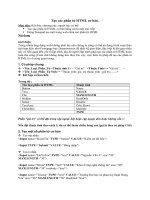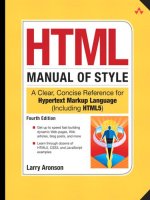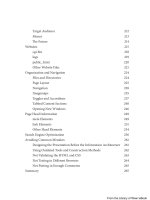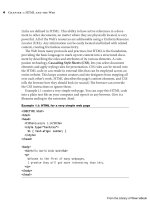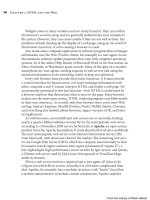HTML cơ bản - p 3 ppsx
Bạn đang xem bản rút gọn của tài liệu. Xem và tải ngay bản đầy đủ của tài liệu tại đây (780.55 KB, 10 trang )
ptg
4 Chapter 1: HTML and the Web
Links are dened in HTML. is ability to have active references in a docu-
ment to other documents, no matter where they are physically located, is very
powerful. All of the Web’s resources are addressable using a Uniform Resource
Locator (URL). Any information can be easily located and linked with related
content, creating frictionless connectivity.
e Web hosts many protocols and practices, but HTML is the foundation,
providing the basic language to mark up text content into a structured docu-
ment by describing the roles and attributes of its various elements. A com-
panion technology, Cascading Style Sheets (CSS), lets you select document
elements and apply styling rules for presentation. CSS rules can be mixed into
the HTML code or can reside in external les that can be employed across an
entire website. is keeps content creators and site designers from stepping all
over each other’s work. HTML describes the page’s content elements, and CSS
tells the browser how they should look (or sound.) e browser can override
the CSS instructions or ignore them.
Example 1.1 creates a very simple web page. You can copy this HTML code
into a plain text le on your computer and open it in any browser. Give it a
lename ending in the extension .html.
Example 1.1: HTML for a very simple web page
<!DOCTYPE html>
<html>
<head>
<title>Example 1.1</title>
<style type="text/css">
h1 { text-align: center; }
</style>
</head>
<body>
<h1>Hello World Wide Web</h1>
<p>
Welcome to the first of many webpages.
I promise they will get more interesting than this.
</p>
</body>
</html>
From the Library of Wow! eBook
ptg
HTML: The Language of the Web 5
e code in Example 1.1 (shown in boldface) consists of two parts: a docu-
ment body containing the page’s content, preceded by a head section that
contains information about the document. In this example, the head section
contains the document’s title and a CSS style rule to center the page’s head-
ing. e body consists of a level 1 heading followed by a paragraph. e result
should look something like Figure 1.1.
Figure 1.1: A simple web page
is brings up a fundamental principle about how the Web works: Web
authors should not make assumptions about their readers, the characteris-
tics of their display devices, or their formatting preferences. is is especially
important with mobile Web users and people with visual disabilities. A Web
author or developer shouldn’t even assume that a site visitor is human! Web-
sites are constantly visited by automated programs that gather and catalog
information about the Web. e general term user agent is used to describe
any soware application or program that can talk to a web server. A modern
website regards visits from all user agents with the same importance as human
visitors using Web browsers. e best approach is to keep the HTML simple
so that it provides a semantic description of the various content elements and
leaves the presentation details to the reader.
e other major player on the Web programming team is JavaScript, a pro-
gramming language that runs inside a browser and manipulates HTML page
elements in response to user actions and other events. ere are other script-
ing languages besides JavaScript, but it is the most popular. Also, JavaScript
syntax and terms are used in the HTML5 specication. Like CSS, JavaScript
code can be embedded within the HTML source code of a web page or can
be imported from a separate le. User agents other than browsers generally
ignore JavaScript and other embedded executable code. It can be dangerous
forrobots.
Robots?!
From the Library of Wow! eBook
ptg
6 Chapter 1: HTML and the Web
Robots are a very important class of Web user. ey are automated
computer programs that run on Internet servers and visit web
pages the same way people do using a browser. But instead of
presenting the page, the robot analyzes it, stores information about
the page in a database, and decides what page to visit next using
that information. is is how Google, Yahoo!, Bing, and other
search engines work. Other robots perform similar data collection for market-
ing and academic purposes. Robots are oen called “spiders” because of how
they seem to “crawl” over the Web from one link to the next. Also, there are
malicious robots. ese automatic programs leave spam comments on blogs or
look for security loopholes to gain control of resources with which they should
not be messing. Bad robots!
When creating content for the Web, you generally are not concerned with
any of this. Most of the HTML structure that deals with browsers, robots,
and widgets is supplied by the Web editing soware you use or by server-side
scripts and template systems. If you are editing content directly online, all you
need to understand is how to mark up the content with simple HTML ele-
ments. Web developers—that is, programmers as opposed to authors—need
to fully understand how these three principal components—HTML, CSS, and
scripting—work together to form the framework of the Web (see Figure 1.2).
Figure 1.2: The three components of a web page
By the way, did I mention that all of this is essentially free? It is free in
two senses of the word. It’s free because there is no acquisition cost, and free
because you can use it for your own purposes. With only minor limitations, all
the HTML, CSS, and scripting that go into a Web page are available for you to
examine, copy, and reuse. Tim Berners-Lee, the inventor of HTML, the URL,
and the HTTP protocol that web servers and user agents use to talk to each
other, put all these components into the public domain. Working at CERN, the
European Center for Nuclear Research, he was trying to nd a better way for
large teams of researchers, working in dierent countries with dierent word
From the Library of Wow! eBook
ptg
A Bit of Web History 7
processors, to quickly publish research papers. Patent rights and Nobel Prizes
were at stake. In a post to the alt.hypertext newsgroup on August 6, 1991,
which was eectively the Web’s birth announcement, Berners-Lee wrote:
e WWW project was started to allow high energy physicists to
share data, news, and documentation. We are very interested in
spreading the web to other areas, and having gateway servers for
other data. Collaborators welcome!
Twenty years later, Berners-Lee is still very much involved in the evolution of
the Web as head of the World Wide Web Consortium (W3C). I stress “evolu-
tion” here to point out that, while the Web has transformed society, freeing
us to work and play in a global sea of information, a lot of that happened by
accident. HTML is still a work in progress.
A B W H
e early Web was text only—without images or colors—and browsers worked
in line mode. In other words, you cursor-keyed your way through page links
sequentially, like browsing on a low-end cell phone. It was not until 1993 that
a graphical browser called Mosaic was made available from the University of
Illinois National Center for Supercomputing Applications (NCSA) in Cham-
paign-Urbana, Illinois. Mosaic was easy enough to install and use on Win-
dows, Macintosh, and UNIX computers.
Mosaic was written by a group of graduate students—principally, Marc
Andreessen and Eric Bina. ey built Mosaic because they were excited by the
possibilities of hypertext and were dissatised by the browsers available at the
time. ey were supposed to be working on their master’s projects.
Mosaic was the progenitor of all modern browsers. It displayed
inline images, multiple font families, weights, and styles, and it
supported a pointing device (a mouse). Distribution of the tech-
nology and Mosaic trademarks was managed for the NCSA by the
Spyglass Corporation and was licensed by Microso, which rewrote the source
code and called it Internet Explorer.
Aer graduating from the University of Illinois, Andreessen teamed up
with Dr. Jim Clark to form Netscape Corporation. Dr. Clark was the former
CEO of Silicon Graphics, Inc., whose sexy, powerful graphics computers/work-
stations revolutionized Hollywood moviemaking. e Netscape Navigator
browser introduced major innovations and became extremely popular because
Netscape Corp. did something quite astounding for the soware industry at
From the Library of Wow! eBook
ptg
8 Chapter 1: HTML and the Web
the time—it gave away Navigator! At its peak, Netscape had captured close to
90% of the browser market.
In 1994, something wonderful happened. Vice President Al Gore, as
chairman of the Clinton administration’s Reinventing Government program,
arranged for the National Science Foundation (NSF) to sell the Internet to a
consortium of telecommunications companies. is ended the NSF’s strict “no
commercial use” policy and gave birth to the dotcom era and jokes about Al
Gore inventing the Internet. In mid-1994 there were 2,738 websites. By the end
of that year there were more than 10,000.
1
From the beginning, competition to commercialize the Internet was erce.
In the mid-1990s, the tech community was abuzz about the “browser wars”
as browser makers threw dozens of extra features into their soware, add-
ing many new elements to HTML that appealed to their respective markets.
Netscape added features that appealed to graphic designers, including sup-
port for jpeg images, page background colors, and a controversial FONT tag
that allowed Web designers to specify text sizes and colors. Microso bundled
Internet Explorer into its Windows operating system and tied Web publishing
into its Microso Oce product line. ese moves resulted in considerable
legal troubles for Microso. ese problems lasted until 2001, when the U.S.
government suddenly dropped its antimonopoly suit against the corporation
in the rst days of George W. Bush’s presidency.
Other companies introduced browsers with interesting ideas but
never captured any signicant market share from Netscape and
Microso. Arena, an HTML3 test bed browser written by Dave
Raggett of Hewlett-Packard (HP), introduced support for tables,
text ow around images, and inline mathematical expressions.
Sun Microsystems came out with a browser named HotJava that generated a
lot of interest. It was written in Java, a programming language that Sun
developed originally for the purpose of controlling TV set-top boxes. Sun
repurposed the language for the Internet with the dream of turning the
browser into a platform for small, interactive applications called applets that
would run in a virtual Java machine in your PC. Sun put Java into the public
domain to encourage its adoption. is allowed Microso to make and market
its own version of the language. Microso’s Java was suciently dierent from
Sun’s version to make using applets (not to mention writing them) dicult.
Although the Java language eventually gained widespread use in building
in-house corporate applications, HotJava died along with Sun’s
Internetdreams.
1. Wikipedia: /> From the Library of Wow! eBook
ptg
A Bit of Web History 9
On a related note, a company called WebTV Networks produced a low-cost
Internet appliance and service for consumers to browse the Web and do email
on their TV sets using a wireless keyboard and remote control. Despite fund-
ing diculties and an on-again/o-again relationship with Sony Corporation
that almost killed the project, WebTV succeeded in bringing the Web and
email to nearly a million customers seeking to avoid the cost and complexity
of personal computer ownership.
To illustrate how weird Web-related events can get, according to Wikipedia,
WebTV was for a brief time classied as a military weapon by the U.S. govern-
ment and was banned from export because it used strong encryption. In 1997,
Microso bought WebTV and rebranded it as MSN TV to expand its Web
oering. Without marketing the service or servicing its customers, MSN TV
died a few years later. But the WebTV technology survived, eventually resur-
facing in Microso’s Xbox gaming console.
One of my favorite Web browsers was Virtual Places, created by an Israeli
company, Ubique. Virtual Places combined Web browsing with Internet chat
soware and enabled collaborative Web surng. It turned any web page into
a virtual chat room where you and other visitors were represented by ava-
tars—small personal icons that you could move around the page. Whatever
you typed in a oating window would appear in a cartoon balloon over your
avatar’s head. It had a “tour bus” feature that allowed a teacher, for example, to
take a group of students to websites around the world and back.
Unfortunately, the server overhead in keeping open connections and track-
ing avatar positions kept Virtual Places from expanding as the number of web-
sites exploded. At the time, Netscape was updating Navigator every few weeks.
Because Ubique couldn’t keep up, nobody used Virtual Places as their default
Web browser. AOL bought Ubique for no apparent reason and sold it to IBM a
few years later. IBM used some of the technology in its soware for corporate
communications and collaboration. Virtual Places died during the dotcom
crash at the start of the twenty-rst century, but the avatars survived.
While Java was hot, Netscape developed JavaScript, a scripting language
that ran in the Netscape Navigator browser and allowed Web developers to
add dynamic behaviors to the HTML elements of a web page. Despite having
the same rst four letters, JavaScript and the Java programming language are
quite dierent. It is suspected that Netscape changed the name from LiveScript
just because of the buzz around Java. Supercially, the code looks similar
because both are object-oriented programming (OOP) systems and have simi-
lar syntax.
From the Library of Wow! eBook
ptg
10 Chapter 1: HTML and the Web
America Online (AOL) acquired Netscape in 1998, and the browser’s
source code was made public. Eventually, this became the foundation on
which the Mozilla organization built the Firefox browser. Other companies
followed suit, and over the ensuing years, a variety of graphical browsers based
on Netscape came to market. Microso’s Internet Explorer (IE) browser
improved with each new version and eventually became the most popular
browser due to its bundling with the Windows operating system.
e browser wars ended with the dotcom crash, and manufacturers began
to bring their browsers into compliance with emerging standards. Under the
W3C’s guidance, HTML language development slowed and stabilized on an
HTML4 specication. e use of CSS was promoted to give Web developers
ner control over typography and page layout over a much wider selection of
devices. HTML attributes and actions (more about these later) were general-
ized. e HTML syntax was modied slightly to conform to XML (eXtensible
Markup Language), and a transition path was provided to the merging of the
two in the XHTML specication.
e way HTML source code looks has changed. Currently, most websites
are written to the HTML4 and/or XHTML standards, in which valid markup
element and attribute names are written using lowercase letters. By contrast,
a web page written to the HTML3 standard is lled with names written in all
uppercase letters. is convention emerged from early website developers, who
had to write HTML without the benet of text editors that provided color syn-
tax highlighting. Using uppercase names provided contrast that distinguished
the markup from the content.
More importantly, the ways in which content creators, soware developers,
and people in general use the Web has evolved dramatically. is change is
encapsulated in the term Web 2.0. Although this suggests a new version of the
World Wide Web, it does not refer to any new technical specications. Instead,
it refers to the changing nature of web pages. e features and functionality
that characterize a Web 2.0 site are a matter of debate. Web 2.0 is better under-
stood as simply a recognition that today’s websites do new things with newer
technology than yesterday’s websites.
Many of these changes have come about due to the embrace of open source
as a philosophy of design and development by the tech community. Much
of the soware that powers the Web is nonproprietary. It is freely available
for people to use, copy, modify, and redistribute as they please. Open-source
development has greatly reduced the cost of soware development while
increasing its availability, stability, and ease of use. Equally interesting is that
From the Library of Wow! eBook
ptg
Uniform Resource Locators (URLs) 11
the Web is self-documenting. Information about what is on the Web, how it is
organized, and how it can be used is everywhere on the Web.
H C O M
Content is everything. Online, it is HTML markup that tells your browser what
that content means and how to present it to you. e concept of markup comes
from traditional print publishing, in which a writer supplies the content,
which an editor then marks up with instructions for the printer, specifying the
layout and typography of the work. e printer, following the markup, type-
sets the pages and reproduces copies for distribution.
With the Web and HTML, the author and the editor are oen the same per-
son. e work, or content, lives in a linked set of HTML les on a web server.
e content is not distributed in discrete copies, as in the print publication
model. Instead, copies of web pages are served in response to user requests.
e information returned by the web server is processed by the user’s browser
to display a web page in a window or tab.
Oen the content of a web page does not reside in an HTML le but is gen-
erated dynamically by the web server from information stored in a database,
using templates to produce web pages. It is common for web page to encom-
pass resources from other servers. at is, a request a browser sends to a web
server may result in that web server making requests of other servers. ese
distinctions, however, are immaterial to the user’s browser. It just downloads
whatever the web server provides without caring how that content was created
or who marked it up.
e technological concepts are simple: an open exchange of data and infor-
mation about that data (metadata), including content and markup. As a con-
nected world of places to visit, the Web is more than a metaphor. e language
of the Web, including verbs such as surf, browse, visit, search, explore, and
navigate, and nouns such as site, home page, destination, gateway, and forum,
creates a very real experience of being someplace.
U R L (URL)
How does a browser know what to request of a web server? How does your
browser know which web server, of the millions in the world, to ask? e
answer, as you’ve probably guessed, is links! A link is a reference, embedded in
the content of a document, to another resource on the Web. is is the essence
of hypertext media.
From the Library of Wow! eBook
ptg
12 Chapter 1: HTML and the Web
e destination of a link is given by a string of characters called a Uniform
Resource Locator (URL). A special bit of HTML markup, called the anchor
element, makes this portion of text, or that image or those buttons, “active.”
When you click one, your browser requests a new document from the web
server indentied in the URL.
In addition to links, URLs are used in HTML to load images, video, and
other online media into a page; to apply stylesheets and create pop-up win-
dows; and to specify where form input should be sent. In HTML a URL can
be in partial form, oen called a relative URL. A browser lls in any missing
parts of the URL from the corresponding parts of the current page’s URL to
create a full URL. is neat trick makes it easy to relocate a website. A full
URL starts with the protocol to use for the transfer. e URL design is uni-
versal and can reference other Internet things besides Web resources. We will
go into more detail later. For now, suce it to say that the Web’s protocol is
HyperText Transport Protocol, abbreviated as “http” or “https” when used in
a URL. e “s” means that a secure (that is, encrypted) connection is made
to the web server so that nobody eavesdropping on the conversation between
your browser and the web server can steal anything important, such as a credit
card number. Otherwise, the https protocol works the same way as http. By
having secure transactions at the protocol level, web page authors and devel-
opers can write HTML that works in either environment.
e web server address comes aer the protocol designation. Following
that, the path to the le or resource is given. (ere’s more, but this will do for
now.) us, when you click a link whose dening anchor element
2
contains a
URL, such as your browser understands
this as a request to open a connection to the Internet server, www.google.com,
using the HTTP protocol and to get the resource, about.html.
Of course, you do not always have to click a link or button to get somewhere
on the Web. You can just type a portion of a URL into the location window at
the top of your browser, and you are taken there. Alternatively, you can open
an HTML le from your local computer. (Web developers commonly do this
when working on a website.)
W B S
As intelligent as Web browsers currently are, web servers are smarter still. A
single web server can host hundreds of dierent websites, manage many dif-
ferent types of content, read/write information from/to databases, and speak
2. <a href=" Google</a>
From the Library of Wow! eBook
ptg
Web Browsers and Servers 13
multiple languages, both human and articial. A web server knows who you
are (to be precise, it knows the Internet address of your computer and what
browser is being used), it keeps track of each request you make, and it logs
whether it was able to comply with the request.
e Web has a client/server architecture, as illustrated in Figure 1.3. Most
Internet protocols are client/server, including File Transfer Protocol (FTP),
email, and many online games. A web server is a computer that resides on a
rack somewhere, or is tucked into a back closet, patiently waiting for a client
program to send it a request it can fulll. As far as the web server is concerned,
anything that sends it a request is considered an important client. In Web-
speak, the client programs are called user agents. Web browsers are the most
important user agents. Robots, or “bots” as they are sometimes called, are
another kind.
File
System
Web Server
User Agent
Web Browser
Search Robot
Database
Server
HTTP Request
HTTP Response
Data
Figure 1.3: The Web’s client/server architecture
Widgets can also be user agents. Loosely dened, a widget is a small com-
puter program. It is packaged so that it can be easily installed as an extension
of a larger computer program, such as a web browser or mobile device, and it
runs in its user interface. A widget can, in response to a mouse click or other
user action, send requests to web servers just like browsers and robots do.
Unlike robots running on large servers, organizing large masses of informa-
tion, a widget typically uses the returned information to update the content in
a specic page element.
From the Library of Wow! eBook

